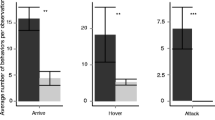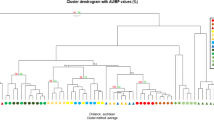Abstract
The salticid spider Cosmophasis bitaeniata preys on the larvae of the green tree ant Oecophylla smaragdina. Gas chromatography (GC) and gas chromatography–mass spectrometry (GC-MS) reveal that the cuticle of C. bitaeniata mimics the mono- and dimethylalkanes of the cuticle of its prey. Recognition bioassays with extracts of the cuticular hydrocarbons of ants and spiders revealed that foraging major workers did not respond aggressively to the extracts of the spiders or conspecific nestmates, but reacted aggressively to conspecific nonnestmates. Typically, the ants either failed to react (as with control treatments with no extracts) or they reacted nonaggressively as with conspecific nestmates. These data indicate that the qualitative chemical mimicry of ants by C. bitaeniata allows the spiders to avoid detection by major workers of O. smaragdina.
Similar content being viewed by others
REFERENCES
Akino, T., Mochizuki, R., Morimoto, M., and Yamaoka, R.1996. Chemical camouflage of myrmecophilous cricket Myrmecophilussp. to be integrated with several ant species. Japanese J. Appl. Entomol. Zool.40:39–46.
Akino, T., Knapp, J. J., Thomas, J. A., and Elmes, G.W.1999. Chemical mimicry and host specificity in the butterfly Maculinea rebeli, a social parasite of Myrmicaant colonies. Proc. R. Soc. London B266:1419–1426.
Allan, R. A., and Elgar, M. A.2001. Exploitation of the green tree ant Oecophylla smaragdinaby the salticid spider Cosmophasis bitaeniata. Aust. J. Zool.49:129–137.
Allan, R. A., Elgar, M. A., and Capon, R. J.1996. Exploitation of an ant chemical signal by the zodariid spider Habronestes bradleyiWalckenaer. Proc. R. Soc. London B263:69–73.
Bagneres, A.-G., Errard, C., Mulheim, C., Joulie, C., and Lange, C.1991. Induced mimicry of colony odours in ants. J. Chem. Ecol.17:1641–1664.
Bagneres, A.-G., Lorenzi, M. C., Dusticier, G., Turillazzi, S., and CLEMENT, J.-L.1996. Chemical usurpation of a nest by paper wasp parasites. Science272:889–892.
Blum, M. S.1987. Specificity of pheromonal signals: a search for its recognitive bases in terms of a unified chemisociality, pp. 401–405, inJ. Eder and H. Rembold (eds.). Chemistry and Biology of Social Insects. Verlag, Munich. 846 ALLAN, CAPON, BROWN, AND ELGAR
Bonavita-Cougourdan, A., Clement, J.-L., and Lange, C.1987. Nestmate recognition: The role of cuticular hydrocarbons in the ant Camponotus vagusScop. J. Entomol. Sci.11:1–10.
Bonavita-Cougourdan, A., Clement, J.-L., and Lange, C.1989. The role of cuticular hydrocarbons in recognition of larvae by workers of the ant Camponotus vagus: Changes in the chemical signature in response to social environment (Hymenoptera: Formicidae). Sociobiology16:49–74.
Bonavita-Cougourdan, A., Clement, J.-L., and Lange, C.1993. Functional subcaste discrimination (foragers and brood-tenders) in the ant Camponotus vagusScop.: Polymorphism of cuticular hydrocarbon patterns. J. Chem. Ecol.19:1461–1477.
Bonavita-Cougourdan, A., Bagneres, A., Provost, E., Dusticier, G., and Clement, J.-L.1997. Plasticity of the cuticular hydrocarbon profile of the slave-making ant Polyergus rufescensdepending on the social environment. Comp. Biochem. Physiol.116B:287–302.
Breed, M. D., Snyder, L. E., Lynn, T. L., and Morhart, J. A.1992. Acquired chemical camouflage in a tropical ant. Anim. Behav.44:519–523.
Brill, J. H., and Bertsch, W.1985. A novel micro-technique for the analysis of the cuticular hydrocarbons of insects. Insect Biochem.15:49–53.
Cushing, P. E.1997. Myrmecomorphy and myrmecophily in spiders: A review. Fla. Entomol.80:165–193.
Dani, F. R., Morgan, E. D., and Turillazzi, S.1996. Dufor gland secretion ofPolisteswasp: Chemical composition and possible involvement in nestmate recognition (Hymenoptera:Vespidae). J. Insect Physiol.42:541–548.
Dejean, A.1990. Circadian rhythm of Oecophylla longinodain relation to territorality and predatory behaviour. Physiol. Entomol.15:393–403.
Dettner, K., and Liepert, C.1994. Chemical mimicry and camouflage. Annu. Rev. Entomol.39:129–154.
Eisner, T., Hicks, K., Eisner, M., and Robson, D. S.1978. “Wolf-in-sheep'-clothing” strategy of a predaceous insect larva. Science199:790–794.
Elgar, M. A.1993. Inter-specific associations involving spiders. Mem. Qld. Mus.33:411–430.
Elmes, G.W., Barr, B., Thomas, J. A., and Clarke, R. T.1999. Extreme host specificity by Microdon mutabilis(Diptera: Syrphidae), a social parasite of ants. Proc. R. Soc. London B266:447–453.
Feener, D. H. J.1995. Headless hosts, legless guests. Nature378:129.
Franks, N., Blum, M., Smith, R. K., and Allies, A. B.1990. Behaviour and chemical disguise of cuckoo ant Leptothorax kutteriin relation to its host Leptothorax acervorum. J. Chem. Ecol.16:1431–1444.
Garnett, W. B., Akre, R. D., and Sehlke, G.1985. Cocoon mimicry and predation by myrmecophilous diptera (Diptera: Syrphidae). Fla. Entomol.68:615–621.
Habersetzer, C.1993. Cuticular spectra and inter-individual recognition in the slave-making ant Polyergus rufescensand the slave species Formica rufibarbis. Physiol. Entomol.18:167–175.
Haverty, M. I., Grace, J. K., Nelson, L. J., and Yamamoto, R. T.1996. Intercaste, intercolony and temporal variation in cuticular hydrocarbons of Coptotermes formosanusShiraki (Isoptera: Rhinotermitidae). J. Chem. Ecol.22:1813–1834.
Haynes, K. F., and Yeargan, K. V.1999. Exploitation of intraspecific communication systems: Illicit signalers and receivers. Ann. Entomol. Soc. Am. 92:960–970.
Hefetz, A., Errard, C., Chambris, A., and Lenegrate, A.1996. Postpharyngeal gland secretion as a modifier of aggressive behavior in the myrmicine ant Manica rubida. J. Insect Behav.9:709–717.
Henderson, G., Anderson, J. F., Phillips, J. L., and Jeanne, R. L.1990. Internest aggression and identification of possible nestmate discrimination pheromones in polygynous ant Formica montana. J. Chem. Ecol.16:2217–2227.
HÖlldobler, B.1971. Communication between ants and their guests. Sci. Am.224:86–93.
HÖlldobler, B.1983. Territorial behaviour in the green tree ant (Oecophylla smaragdina). Biotropica15:241–250. HYDROCARBON MIMICRY BY SPIDERS 847
HÖlldobler, B., and Wilson, E. O.1978. The multiple recruitment systems of the African weaver ant Oecophylla longioda(Lareille) (Hymenoptera: Formicidae). Behav. Ecol. Sociobiol.3:19–60.
HÖlldobler, B., and Wilson, E. O.1990. The Ants. Harvard University Press, Cambridge, Massachusetts.
Howard, R. W.1992. Comparative analysis of cuticular hydrocarbons from the ectoparasitoids Cephalonomia waterstoniand Laelius utilis(Hymenoptera, Bethylidae) and their respective hosts, Cryptolestes ferrugineus(Coleoptera, Cucujidae) and Trogoderma variabile(Coleoptera, Dermestidae) Ann. Entomol. Soc. Am.85:317–325.
Howard, R. W., and Infante, F.1996. Cuticular hydrocarbons of the host-specific ectoparasitoid Cephalonomia stephanoderis(Hymenoptera, Bethylidae) and its host the coffee berry borer (Coleoptera, Scolytidae). Ann. Entomol. Soc. Am.89:700–709.
Howard, R. W., McDaniel, C. A., and Blomquist, G. C.1980. Chemical mimicry as an integrating mechanism: cuticular hydrocarbons of a termitophile and its host. Science210:431–433.
Howard, R. W., McDaniel, C. A., Nelson, D. R., Blomquist, G. J., Gelbaum, L. T., and Zalkow, L. H.1982. Cuticular hydrocarbons of Reticulitermes virginicus(Banks) and their role as potential species-and caste-recognition cues. J. Chem. Ecol.8:1227–1239.
Howard, R. W., Akre, R. D., and Garnett, W. B.1990a. Chemical mimicry in an obligate predator of carpenter ants (Hymenoptera: Formicidae). Ann. Entomol. Soc. Am.83:607–616.
Howard, R. W., Stanley-Samuelson, D. V., and Akre, R. D.1990b. Biosynthesis and chemical mimicry of cuticular hydrocarbons from the obligate predator, Microdon albicomatusNovak (Diptera: Syrphidae) and its ant prey, Myrmica incompletaProvancher (Hymenoptera: Formicidae). J. Kans. Entomol. Soc.63:437–443.
Jaffe, K.1983. Chemical communication among workers of the leaf-cutting ant Atta cephalotes, pp. 165–180, inP. Jaisson (ed.). Social Insects in the Tropics, Vol. 2. University of Paris, Paris, France.
Jaisson, R. D.1991. Kinship and fellowship in ants and social wasps, pp. 60–93, inP. G. Hepper (ed.). Kin Recognition. Cambridge University Press, Cambridge, United Kingdom.
Kaib, M., Heinze, J., and Ortius, D.1993. Cuticular hydrocarbon profiles in the slave-making ant Harpagoxenus sublaevisand its hosts. Naturwissenschaften80:281–285.
Keegans, S. J., Billen, J., and Morgan, E.D.1991.Volatile secretions of the green tree ant Oecophylla smaragdina(Hymenoptera: Formicidae). Comp. Biochem. Physiol.100B:681–685.
Kistner, D. H.1979. Social and evolutionary significance of social insect symbionts, pp. 339–413, inH. R. Hermann (ed.). Social Insects, Vol. 1. Academic Press, London.
Lenoir, A., D'Ettorre, P., Errard, C., and Hefetz, A.2001. Chemical ecology and social parasitism in ants. Annu. Rev. Entomol46:573–599.
Liepert, C., and Dettner, K.1993. Recognition of aphid parasitoids by honeydew-collecting ants: The role of cuticular lipids in a chemical mimicry system. J. Chem. Ecol.19:2143–2153.
Liepert, C., and Dettner, K.1996. Role of cuticular hydrocarbons of aphid parasitoids in their relationship to aphid-attending ants. J. Chem. Ecol.22:695–707.
Lockey, K. H.1988. Lipids of the insect cuticle: Origin, composition and function. Comp. Biochem. Physiol.89B:595–645.
Lokkers, C.1986. The distribution of the weaver ant, Oecophylla smaragdina(Fabricius) (Hymenoptera: Formicidae) in northern Australia. Aust. J. Zool.34:683–687.
Lokkers, C.1990. Colony Dynamics of the green tree ant (Oecophylla smaragdina) in a seasonal tropical climate. PhD thesis. James Cook University, Queensland.
Morel, L., Vander Meer, R. K., and Lavine, B. K.1988. Ontogeny of nestmate recognitiion cues in the red carpenter ant (Camponotus floridanus). Behav. Ecol. Sociobiol.22:175–183.
Moritz, R. F. A., Kirchner, W. H., and Crewe, R. M.1991. Chemical camouflage of the death' head hawkmoth (Acherontia atropos L.) in honeybee colonies. Naturwissenchaften78:179–182. 848 ALLAN, CAPON, BROWN, AND ELGAR
Provost, E., Riviere, G., Roux, M., Bagneres, A. G., and Clement, J. L.1994. Cuticular hydrocarbons whereby Messor barbarusant workers putatively discriminate between monogynous and polygynous colonies. Are workers labeled by queens? J. Chem. Ecol.20:2985–3003.
Smith, B. H., and Breed, M. D.1995. The chemical basis for nest-mate recognition and mate discrimination in social insects, pp. 287–317, inR. T. Cardé and W. J. Bell (eds.). Chemical Ecology of Insects 2. Chapman and Hall, London.
Soroker, V., Vienne, C., and Hefetz, A.1994. The postpharyngeal gland as a “Gestalt” organ for nestmate recognition in the ant Cataglyphis niger. Naturwissenschaften81:510–513.
Su, N.-Y., and Haverty, M.1991. Agonistic behaviour among colonies of the Formosan subterraenean termite, Coptotermes formosanusShiraki (Isoptera: Rhinotermitidae), from Florida and Hawaii: Lack of correlation with cuticular hydrocarbon composition. J. Insect Behav.4:115–128.
Takahashi, S., and Gassa, M.1995. Roles of cuticular hydrocarbons in intra-and interspecific recognition behaviour of two Rhinotermitidae. J. Chem. Ecol.21:1837–1845.
Thomas, M. L., Parry, L. J., Allan, R. A., and Elgar, M. A.1999. Colony recognition in Australian meat ants Iridomyrmex purpureus. Naturwissenchaften86:87–92.
Vander Meer, R. J., and Wojcik, D. P.1982. Chemical mimicry in the myrmecophilous beetle Myrmecaphodius excavaticollis. Science218:806–808.
Vander Meer, R. K., Jouvenaz, D. P., and Wojcik, D. P.1989. Chemical mimicry in a parasitoid (Hymenoptera: Eucharitidae) of fire ants (Hymenoptera: Formicidae). J. Chem. Ecol.15:2247–2261.
Vauchot, B., Provost, E., Bagneres, A. G., and Clement, J. L.1996. Regulation of the chemical signatures of two termite species, Reticulitermes santonensisand Reticulitermes lucifugus grassei, living in mixed experimental colonies. J. Insect Physiol.42:309–321.
Vauchot, B., Provost, E., Bagneres, A. G., Riviere, G., Roux, M., and Clement, J. L.1998. Differential adsorption of allospecific hydrocarbons by the cuticles of two termite species, Reticulitermes santonensisand R. lucifugus grassei, living in a mixed colony. J. Insect Physiol.44:59–66.
VÖlkl, W.1995. Behavioral and morphological adaptations of the coccinellid, Platynaspis luteorubrafor exploiting ant-antended resources (Coleoptera: Coccinellidae). J. Insect Behav.8:653–670.
VÖlkl, W., and Mackauer, M.1993. Interactions between ants attending Aphis fabaessp. cirsiiacanthoidison thistles and foraging parasitoid wasps. J. Insect Behav.6:301–312.
VÖlkl, W., Liepert, C., Birnbach, R., Hubner, G., and Dettner, K.1996. Chemical and tactile communication between the root aphid parasitoid Paralipsis enervisand trophobiotic ants: Consequences for parasitoid survival. Experientia52:731–738.
Way, M. J.1954. Studies of the life history and ecology of the ant Oecophylla longinodaLatreille. Bull. Entomol. Res.45:93–112.
Weissflog, A., Maschwitz, U., Disney, R. H. L., and Rosciszewski, K.1995. A fly' ultimate con. Nature378:137.
Author information
Authors and Affiliations
Corresponding author
Rights and permissions
About this article
Cite this article
Allan, R.A., Capon, R.J., Brown, W.V. et al. Mimicry of Host Cuticular Hydrocarbons by Salticid Spider Cosmophasis bitaeniata That Preys on Larvae of Tree Ants Oecophylla smaragdina . J Chem Ecol 28, 835–848 (2002). https://doi.org/10.1023/A:1015249012493
Issue Date:
DOI: https://doi.org/10.1023/A:1015249012493




